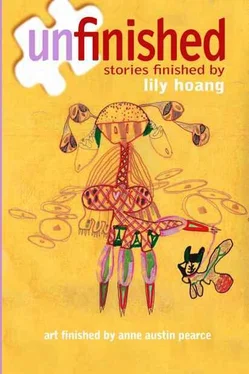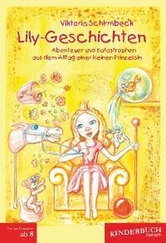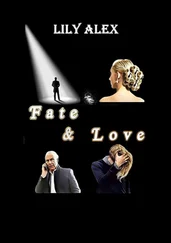Lily Hoang - Unfinished - stories finished by Lily Hoang
Здесь есть возможность читать онлайн «Lily Hoang - Unfinished - stories finished by Lily Hoang» весь текст электронной книги совершенно бесплатно (целиком полную версию без сокращений). В некоторых случаях можно слушать аудио, скачать через торрент в формате fb2 и присутствует краткое содержание. Издательство: Jaded Ibis Press, Жанр: Современная проза, на английском языке. Описание произведения, (предисловие) а так же отзывы посетителей доступны на портале библиотеки ЛибКат.
- Название:Unfinished: stories finished by Lily Hoang
- Автор:
- Издательство:Jaded Ibis Press
- Жанр:
- Год:неизвестен
- ISBN:нет данных
- Рейтинг книги:5 / 5. Голосов: 1
-
Избранное:Добавить в избранное
- Отзывы:
-
Ваша оценка:
- 100
- 1
- 2
- 3
- 4
- 5
Unfinished: stories finished by Lily Hoang: краткое содержание, описание и аннотация
Предлагаем к чтению аннотацию, описание, краткое содержание или предисловие (зависит от того, что написал сам автор книги «Unfinished: stories finished by Lily Hoang»). Если вы не нашли необходимую информацию о книге — напишите в комментариях, мы постараемся отыскать её.
Unfinished: stories finished by Lily Hoang — читать онлайн бесплатно полную книгу (весь текст) целиком
Ниже представлен текст книги, разбитый по страницам. Система сохранения места последней прочитанной страницы, позволяет с удобством читать онлайн бесплатно книгу «Unfinished: stories finished by Lily Hoang», без необходимости каждый раз заново искать на чём Вы остановились. Поставьте закладку, и сможете в любой момент перейти на страницу, на которой закончили чтение.
Интервал:
Закладка:
XII.
Curator 21588 wears knee socks without any shoes. That way, he can move in utter silence.
Curator 9374865 composes an algebra of the unreal.
Curator 258 is a fraud. Management believes he suffers from sciophobia when it is the loss of his shadow that he fears. Thus he walks the halls, a lamp attached to his fannie pack like an intravenous drip, his shadow always trailing behind him.
Curator 1311 keeps the Deus Ex Machina’s mainsprings and clickwheel in working order.
Curator 8204 is the resident entropist. All questions regarding multiplicity, disorder, and time’s arrow should be left in his inbox. Most responses are received the day before yesterday.
Curator 258 spends all day meditating on the yawning chasm between the nest and the cage.
Curator 3000 wears a powder puff tutu with bodice made of white lace and tulle to staff meetings.
Curator 9 has a head of wax and the heart of a sick child.
XIII.
The ceiling — in its original ceiling form — was not straight, and wanting to maintain some sense of continuity with the original Museum’s overall aesthetic, the curators and executives joined together to declare that the new — now the old — glass ceiling should have unique topography as well, but of course, this new topography had to be a mere nod to the old topography rather than an imitation, as one particularly short-sighted Docent had suggested.
When the new-old glass ceiling was broken by the little boy with the slingshot and a newnew glass ceiling was needed, the employees banded together and asked Gretchen that their new ceiling be slightly changed. They asked her: (1) for the glass to be clear rather than kaleidoscopically tinted; (2) for the ceiling to have fewer sharp curves, as they became increasingly difficult to clean (the glass itself grew in its tireless effort to reach more sunlight); and (3) that there be ultraviolet ray protection in the glass, as none of the employees wanted skin or eye damage due to their lengthy hours in the Museum.
Gretchen, being the magnanimous donor that she is, gave them a new-new ceiling, a rollercoaster of smooth blown glass, a radiant spectrum in the sun, providing only the sneakiest of shadows, depending on the time of day, and not only ultra-violet protection but also glare-proof glass.
In the Museum’s repetitive world, image is a predatory thing. Coatings induce that noticeable funhouse mirror effect. They create that soda bottle look. They block light.
XIV.
As mentioned before, the Museum, before it was a museum, was a floating island of garbage, a garden grove, a cairn. It was also dictionary in a bottle, a Wunderkammer, and a pregnant man. Just before it was a Museum, it was dollhouse of sorts. Back then, it belonged to Maggie, but when Maggie was six, she lost it to Gretchen in an intense game of GO FISH. And so of course, it was Gretchen who founded the Museum of Oddities and Eccentricities and brought it to its present form.
XV.
While there are ever-shifting exhibits, the Museum houses only four displays (one is not available for public viewing). Each has an official bronze-plated placard. The first display is a giant golden retriever. He responds to commands in several languages — including both Latinate and tonally derived Oriental languages and all their offshoots, and may even engage in prolonged conversation. He has an incredible ear for intervallic quality, motivic relationships, textural patterns, and unnatural inflections. He has marked proficiency in Greek, Ancient not Modern. He has some difficulty with a few of the Slavic languages though, except for Russian. He is also fluent in Esperanto; it is, in fact, his preferred method of communication. For instance, you may hear some of these phrases from its snarling rictus: La bestoj estas hundoj (The animals are dogs); Hundo trinkas (A dog drinks (or: is drinking)); La kato ludas (The cat plays (or: is playing)); Hundoj kuras (Dogs run (or: are running)); La hundo estas ludas (The dog is playing); Kato ludas (A cat plays (or: is playing)); Katoj ne kuras (Cats do not run (or: are not running)); Estas kato sub la tablo (There is a cat under the table); La hundo estas la amiko de la kato (The dog is the friend of the cat). But by far its favorite phrase is La rozo ne estas frukto (The rose is not a fruit).
The dog’s bronze placard travels with him around his neck and includes not only his name, emergency information — in the unfortunate chance that he gets loose! — and his rabies vaccination date. But on the flip side, inscribed into the placard, is the reason why this one particular golden retriever is a part of the Museum. The problem arises, however, because the dog himself inscribed the tag, and although he is competent in the languages of persons, he vehemently argued that he wanted to write in his most natural language, the language — he said — of the greatest poets and philosophers, namely, dog.
The second display is the floor, which is a mirror of wonders. The floor reflects not the future or the present, your deepest desires or your greatest fears. Instead, the Museum’s floors display you before you were you. It shows who or what you were in your previous incarnation.
This can often be a frightening scene. Imagine walking around and suddenly, from the bottom corner of your eye, you see not yourself directly below your feet but a rock or a lizard, or if you are very very lucky, someone famous but ultimately unrecognizable. We have only recognized one reincarnate, but we could not reveal to them who they were. We cannot point out to others the Floor of Incarnations. It is a rule in the Big Book. Those who come in must know to look beneath to see who they really are.
The Floor of Incarnations’ placard reads more like a warning or a legal document than an explanation, which is what most persons are mainly interested in, but this, of course, is not something the Museum — as it resists explanatory efforts — can readily or easily reveal.
The third display is the employees themselves. Like the golden retriever, they are also wandering displays, and like all the displays in the Museum, their oddity or eccentricity is not always obvious or apparent to the average Museum-goer, but those with a subtle sense of understanding can easily see why the employees fit here.
The placards for this display show only a number. These unique numbers refer back to a book of application, which is always available for inspection. Unfortunately, the employees are real tricksters and enjoy trading placards with each other, such that there is no methodical way to insure who belongs to what number within fifteen minutes of the Museum’s opening.
The final display is private.
XVI.
In the Museum, there are no names, only numbers. Every morning, the employees enter the Museum with their placards and they check the Big Book to tell them who they are. The Big Book reminds them of their personalities and truths, which they may have forgotten after sleep, but just as soon as they fully grasp exactly who it is that they are, they swap placards, or their placards are stolen or replaced or lost, and they must pilgrimage back to the Big Book to learn about themselves all over again.
XVII.
There is exactly one placard per employee at the Museum. There are no extras. There is no room for that much horsing around. Anyone missing a placard is no longer an employee. They become mere observers. They are visitors.
And the opposite can also be true. If a visitor to the Museum steals an employee’s placard, they become part of the staff. They are a part of the Museum and, until they are fired, their allegiance must remain with the Museum. They can no longer go to school, go to their banal office jobs, etc. It is a steep penalty, but even bad little boys must learn the consequences of misbehavior.
Читать дальшеИнтервал:
Закладка:
Похожие книги на «Unfinished: stories finished by Lily Hoang»
Представляем Вашему вниманию похожие книги на «Unfinished: stories finished by Lily Hoang» списком для выбора. Мы отобрали схожую по названию и смыслу литературу в надежде предоставить читателям больше вариантов отыскать новые, интересные, ещё непрочитанные произведения.
Обсуждение, отзывы о книге «Unfinished: stories finished by Lily Hoang» и просто собственные мнения читателей. Оставьте ваши комментарии, напишите, что Вы думаете о произведении, его смысле или главных героях. Укажите что конкретно понравилось, а что нет, и почему Вы так считаете.






![О Генри - Неоконченный рассказ [An Unfinished Story]](/books/415443/o-genri-neokonchennyj-rasskaz-an-unfinished-story-thumb.webp)





